Enough rope to hang themselves
Rope is a bit of an odd duck in the Alfred Hitchcock canon, both transitional and anomalous. It’s his first color film, but more importantly, it’s his biggest foray into the single-take illusion, a gimmick to which the the entire story is tightly bound (pun intended). Unlike the inside-out design of Rear Window, Rope is less a towering masterstroke that happens to have a high concept and more of an experiment with a mix of triumphs and failures. As much as it’s a one-off, it’s a series of important firsts: the first fruit of Hitchcock’s independence from producer David O. Selznick; and only his second project as his own producer after Notorious. It’s a dipped toe in Technicolor that Hitchcock would iterate upon masterfully in Vertigo among others. And it’s the director’s first of many pairings with Jimmy Stewart. Even with its quirks, it is still unmistakably a Hitchcock film, and a great one: packed with suspense, guilty psychology, and a perverse crime that mirrors the hangups of its heroes and villains (in this case, one in the same).
Rope opens with a bang; or, rather, a scream: Two privileged young men, Brandon (John Dall) and Phillip (Farley Granger), strangle their former classmate David Kentley (Dick Hogan) in the opening moments of the film. They do it not out of revenge or desperation but for the sick thrill of it — a smug exercise in Nietzschean superiority, a “perfect murder” to prove they can. (The story is inspired by the real-life Leopold and Loeb murder case in which two young men killed a fourteen year old in an elaborate plot with similar motivation.) The pair stash David’s body inside a chest in their penthouse apartment, then promptly host a dinner party for David’s friends and family, serving food and small talk atop the hidden corpse.
The guest list at this soiree-slash-secret funeral is a reflection of the various toxic aspects of wealthy, metropolitan young adulthood. The attendees include David’s father (Cedric Hardwicke) and dotty aunt (Constance Collier) as a look at the role of the older generation losing touch. David’s fiancée Janet (Joan Chandler) and her ex-flame Kenneth (Douglas Dick) serve as lenses into the role of money in shaping relationships and young love. Also bustling around around is the housekeeper Mrs. Wilson (Edith Evanson), a constant reminder of Brandon and Phillip’s lack of self-sufficiency despite their claims of superiority. (She’s also a constant threat to discover the body in the chest.) Most importantly, there’s Rupert Cadell (James Stewart), the former prep school housemaster for the students who initially espoused the kind of amoral intellectual bravado that Brandon and Phillip have twisted into bloodshed. Brandon practically salivates at Rupert’s approval; Phillip, already cracking under the strain, can barely look him in the eye.
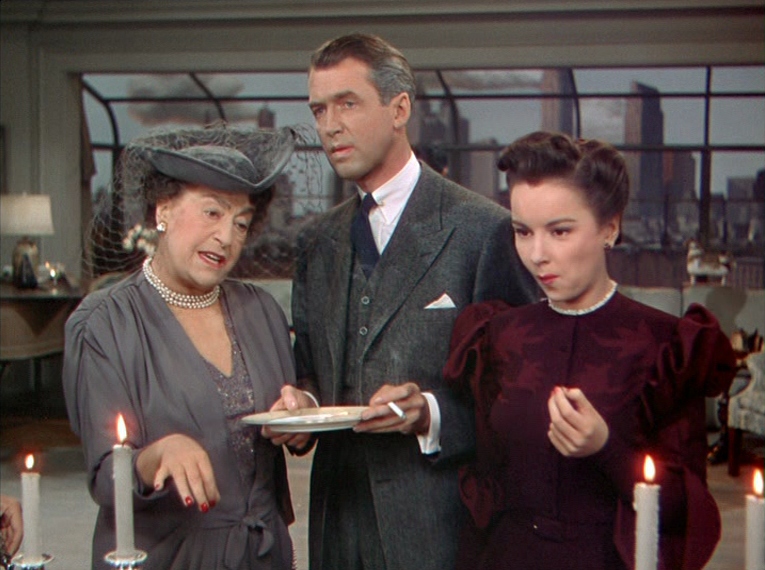
Tension simmers at first, then boils, as cocktails flow and Brandon and Phillip come closer to letting their lie slip. The camera — bound by the film’s long-take, real-time conceit — keeps circling the chest, ensuring that even as the conversation between characters bounces around, the audience never forgets the dark heart of the gathering. The film’s most agonizing sequence comes not during an accusation or confession or chase, but the slow, banal cleaning of the chest. Mrs. Wilson, dutiful as ever, begins tidying up the buffet atop the chest, serving almost as an altar, removing one object after another until she’s about to open it and and discover the telltale corpse. For an unbearable stretch, the film traps us between rooting for discovery and fearing it as Mrs. Wilson makes one trip to the kitchen after another. It’s an outright masterful moment of suspense, even at Hitchcock’s high standards.
It gradually becomes clear that the wedge into solving the mystery is Stewart’s Rupert, whose favor Brandon and Phillip covet almost to the level of infatuation. Rupert slowly recognizes Brandon and Phillip’s behavior as strained and bizarre, the glint in their eyes a little too unhinged. He applies his own detective skills, and he starts to see a vision of his own worst impulses come to life. Confronting it forces Rupert to see the grotesque real-world consequences of the dangerous ideas he treats as a parlor game.
The film’s inciting crime is an act of baroque cruelty masquerading as a high-minded intellectual exercise. The corpse in the chest is uncommonly provocative as a narrative and visual center of gravity. It’s Pandora’s box, life and death on the brink with the potential to detonate if the chest opens. The scenario does not require any sort of symbolic interpretation to work, but it practically begs for one. Perhaps the obvious one is viewing the hidden corpse as the manifest danger of the philosophy of Nietzsche and ubermensch ethics that Brandon, Phillip, and Rupert espouse, all of which have fascist undertones and are tightly linked to Nazi Germany that had just fallen a couple years earlier.
The common reading of Brandon and Phillip as a closeted couple is hardly subtle. In adapting Patrick Hamilton’s stage play, Hitchcock and screenwriter Arthur Laurents, himself gay, laced the film with indicators: easy intimacy between the pair, shared living space, intertwined psyches, motifs of dominance and submission. The Hays Code prevented any explicit acknowledgment, and it may work better as an unspoken pull anyways. But it glows just under the surface, gives an edge to the pair’s worship of Rupert such that it starts to resemble attraction, and aligns with Hitchcock’s tradition of linking queerness with violent impulses.
Seen through that lens, the body in the chest offers another possible meaning: it’s a rotting symbol of guilt, self-loathing, and the invisible but always-present burden of living a life unaccepted by the world. It’s the monstrous secret that Brandon and Phillip have both metaphorically and literally trapped inside their apartment, the thing they alternately flaunt and dread discovery of. Rope’s tension is therefore amplified: Will they get caught for the crime, and will the world see them for what they truly are? The implications extend beyond the pair’s sexuality alone, touching anyone whose identity or ambitions don’t cleanly fit the mold of postwar Manhattan’s polite society. It could even be the general shame of an upper class, fascist-leaning cast of elites trying to understand their place in a world that just defeated Nazi German.
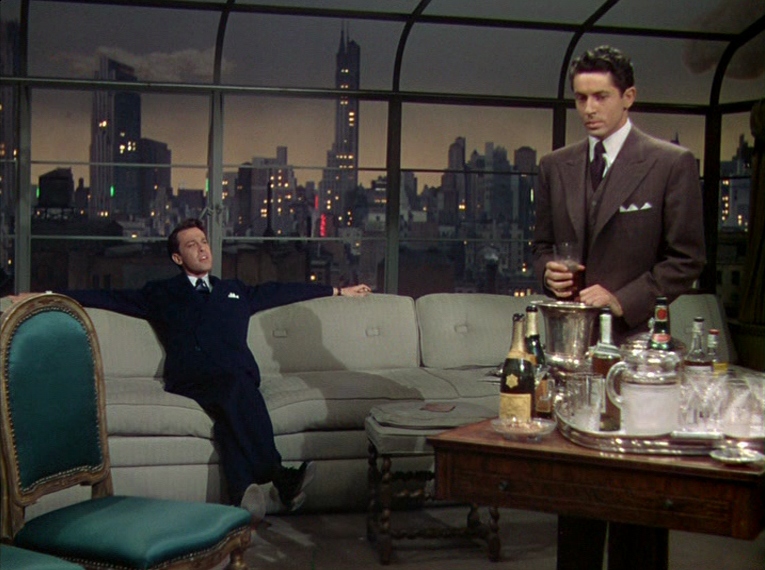
Brandon and Phillip embody two radically different ways of coping with that dissonance. Brandon, all preening confidence and brittle cruelty, is comfortable flaunting the rules he believes himself above. He’s not just proud of their crime; he practically wants to be caught, if only to bask in the affirmation of his own superiority for executing such a “perfect crime.” Phillip, meanwhile, sweats and crumbles, his nerves raw from the moment the film starts. His guilt is almost unbearable to watch. Together, they form a duality of of anxiety and arrogance, each feeding the other toward their collapse in the closing minutes.
Whatever Rope’s flaws or quirks, its core strength as a small-scale suspense film with a provocative setup is undeniable. The pace, despite the long-take formalism, is well-shaped — any runtime longer than its 80 minutes would strain, but it flows wonderfully at this length. Hitchcock teases out and builds tension with precision: first intrigue at the very concept of a party celebrating a death without the guests knowing, the evidence right under their noses. The tension builds incrementally: half-glances, quavers in the voice, blips of unease. Hitchcock uses the camera not merely as a recording device but as a participant in the drama, aligning our gaze with the traps he’s laid out so we can track the building pressure.
The careful use of camera gaze, and aligning us with Brandon and Phillip also makes this a key development in Hitchcock’s work placing us in the heads and hearts of monsters, a concept he would explode out into radical terms 12 years later in Psycho.
It helps that Dall and Granger deliver wonderful performances tailor-made for Hitchcock’s needs, distinct but compatible. Brandon as rendered by Dall is an anti-hero worth savoring, his urbane haughtiness both charismatic and snakelike — it belongs in the Hitchcock Hall of Fame. Granger, for his part, gives a raw-nerve turn that’s almost too on edge. His Phillip is a man reverberating with guilt to the point you wonder why he’d participate in the crime in the first place. He’s the negative image and complement to Brandon’s arrogance. It’s easy to see why Hitchcock would recast Granger as the morally compromised lead of Strangers on a Train a few years later.
If Dall and Granger feel close to ideal for their parts, Stewart is a less intuitive fit, though still undeniably great. In later Hitchcock collaborations like Vertigo and Rear Window, Hitchcock would mine the tension between Stewart’s genial everyman persona and his character’s buried darkness to wondrous, all-time great effect. Here, though, that same dissonance is a little harder to get a grip on. Rupert as written suggests an aura of menace and moral slipperiness that lets the audience buy into his complicity and genuine belief in Brandon and Phillip’s ideas about justified murder to feel credible. Stewart’s affability cuts against. It’s easy to imagine someone like Vincent Price, with his natural intensity and ability to carry both charm and threat in every syllable. And yet I’ve come to love Stewart’s turn here as a man who passes as respectable but has a dangerous edge. He brings nuance that deepens Rupert.
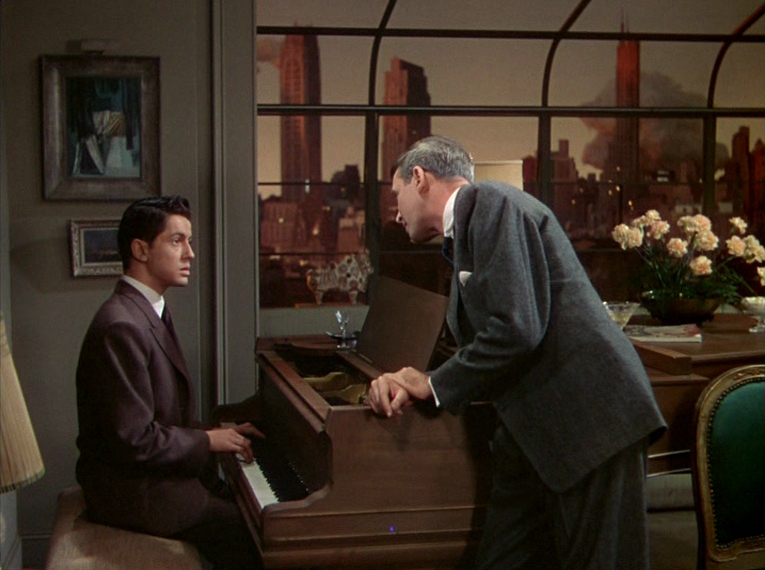
The rest of the ensemble is solid but mostly unremarkable. Chandler makes an adorable girl-next-door romantic interest; I would have loved to have seen her in another Hitchcock film, but her acting credits are slim. Only Collier as David’s aunt threatens to tip the tone out of whack, leaning heavily into stagey transatlantic affectations that grow grating as the party drags on. Still, the supporting performances are just textured enough to keep the film flowing and interesting.
Rope is deeply bound to its stage roots, and yet Hitchcock shapes it to his will like a wizard or a god. For his very first independently produced film, he went for a film that seems straightforward and small-scale but is dependent upon technical wizardry: walls shift, prop roll, and the camera dollies relentlessly. The linear time constraint does mean a couple moments have a slight pause to them, but like a simmering stew, it only builds the flavor and anticipation. Some of the philosophical exchanges are on-the-nose and quips about uppercrust life not especially rich, yet it’s all plausible as banter at a party for snooty intellectuals. (And, as Hitchcock himself said, dialogue is mostly “another noise,” subservient to the visuals, and I think that holds here.)
Every now and then, Hitchcock seems unsure how to elegantly fit his usual cinematic grammar into the single-shot limitation that gives the movie its identity. Hitchcock, a master manipulator of cinematic time and space through editing bordering on montage, is a bit hemmed in by the long-take structure. The best Hitchcock sequences can give the sensation of time expanding or contracting as the suspense requires through the pulse of cutting and the daring of shot construction. Here, his outstanding craft works despite the restrictions and around them, not because of them. The technique imposes a rigidity on the timing of reveals and reversals, trading some of the director’s usual artful play with rhythm for the steady beat of a single, flowing gaze.
And yet, he makes the most of it, constructing applying his instincts on zooming, composition, and carefully blocked visual storytelling to the long takes. It honestly makes me admire the director even more; that he could make this level of tension work within such a rigid structure that requires such detailed planning shows Hitchcock’s supercomputer brain when it comes to calculating cinema’s maximum thrilling power. Even the lighting gets in on the action — an ever present sunset in the background aligns nicely with the moral descent on display, light fading to darkness as the story builds to its confrontational climax.
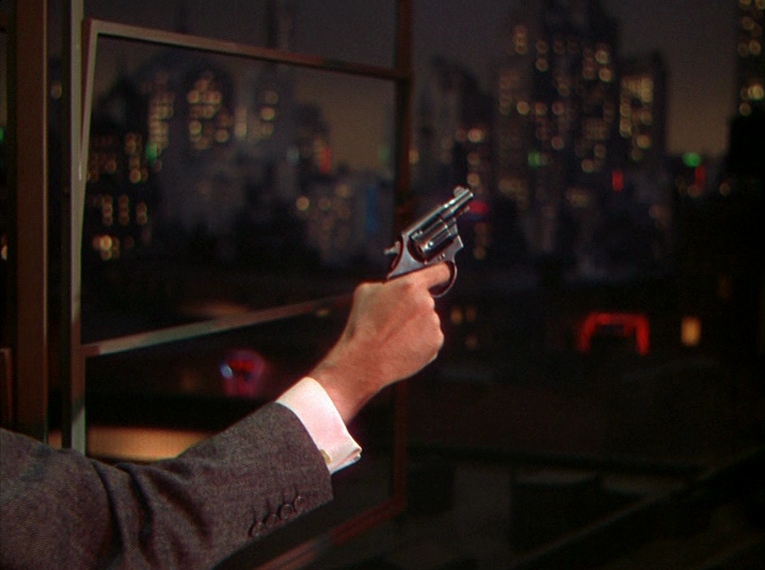
And I’ll get the technicality out of the way here: Despite the “single-shot” descriptor that I’ve used and that many accounts use, Rope was not truly shot in a single take. Rather, it’s a series of long takes cleverly stitched together, often by hiding a cut in the back of a character passing in front of the lens or zooming past a piece of furniture to briefly obfuscate the scene. There are even a couple obvious no-trick cuts. Hitchcock masks most of the transitions as well as he could given the reel-change limitations of 1940s cameras.
After it left theaters in 1948, Rope went largely unseen for years. Hitchcock pulled it, along with a handful of his other films, from circulation in the 1950s, and they wouldn’t properly reemerge until the 1980s. Critics and Hitchcock-heads expressed some bafflement at the film upon its re-release, but over time its repute has grown. (That confusion-to-worship arc matches my own feelings over time about the film, incidentally.)
Rope is an oddity for the Master of Suspense, and one he felt coldly about as he aged. He described the film as a messy experiment, and expressed that he disliked rather than valued the limitations it brought. (In his seminal series of interviews with Francois Truffaut, he is quite persnickety about the lighting and color of the sunset.) Rope is not quite a Pantheon-level Hitchcock film for me, but it’s close: The suspense is thick. The well-acted moral queasiness baked into its premise puts us in the heads of sickos hiding their derangement in plain sight. This psychological intensity gives the film gravity and heft, more than the technical achievement does; though, as with any Hitchcock movie, the psychology and the technicality are intermingled. Rope’s bumpy patches are endearing quirks rather than movie-hindering flaws. Hitchcock’s capacity to stage and sustain tension is on full display, an ever-tightening rope around the necks of Brandon, Phillip, and the audience.
Is It Good?
Exceptionally Good (7/8)
Related Articles
Dan is the founder and head critic of The Goods. Follow Dan on Letterboxd. Join the Discord for updates and discussion.

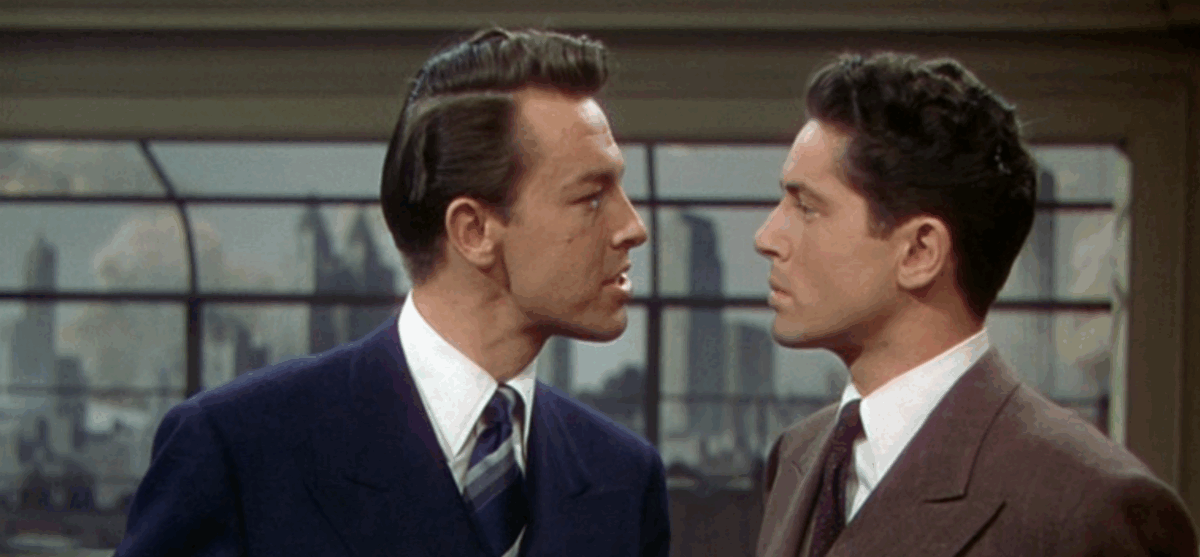
2 replies on “Rope (1948)”
This is–I haven’t seen every last one, but I think unassailably–my favorite Hitchcock. It’s one of the supreme exercises in cinematic perversity, aligning your interests in an entertaining movie with the antisocial interests of freakish killers to continue getting away with it (better than even Psycho or Dial M); the pressurized formal conceit and the high-wire act of some of the choreography it entails perfectly bolsters that, and while it’s clunky, the clunkiness is sort of its own reward, just watching the movie itself strain the same way its villain protagonists do. (I do think it manages to compress time, oddly enough, despite the conceit: it’s way too short for the lighting conditions “outside” to shift so much, from broad daylight to actual nighttime.) And I love Stewart in this, I think he does his best work is with edgy characters (e.g., After the Thin Man).
All that said, I guess I don’t really *disagree* with any of the critiques, as full-on loving it is more a matter of taste. I do think it’s a fun insight that the whole thing could be a “closeting” metaphor, though I’ve generally approached its story, thematically, from Cadell’s vector and with the immediate post-WWII timeframe in mind, basically “dipshit crypto-fascist stunned by the consequences of his ideas.” Still, over time I’ve come to think there’s something of a love triangle sort of thing going on–“look how worthy I am of your attention, Rupert!”–that Brandon is entirely miscalculating if he’s even entirely consciously aware of it.
WHOA Your favorite Hitch! I wish I had a less predictable favorite than Vertigo (though my exploration is still ongoing). I definitely respect it as a pick — there’s a purity and commitment to it — especially if for you “clunkiness is sort of its own reward.”
I like the way you’ve outlined the “dipshit crypto-fascist stunned by the consequences of his ideas” reading enough (it really does align with Cadell’s arc) that I’ve actually rewritten a couple paragraphs in this review, hope you don’t mind, haha.
In the handful of times I’ve circled back to ones I’ve already seen, I usually find I respond to Hitchcock movies quite different the second time through. We’ll see how I feel if I ever rewatch Rope.